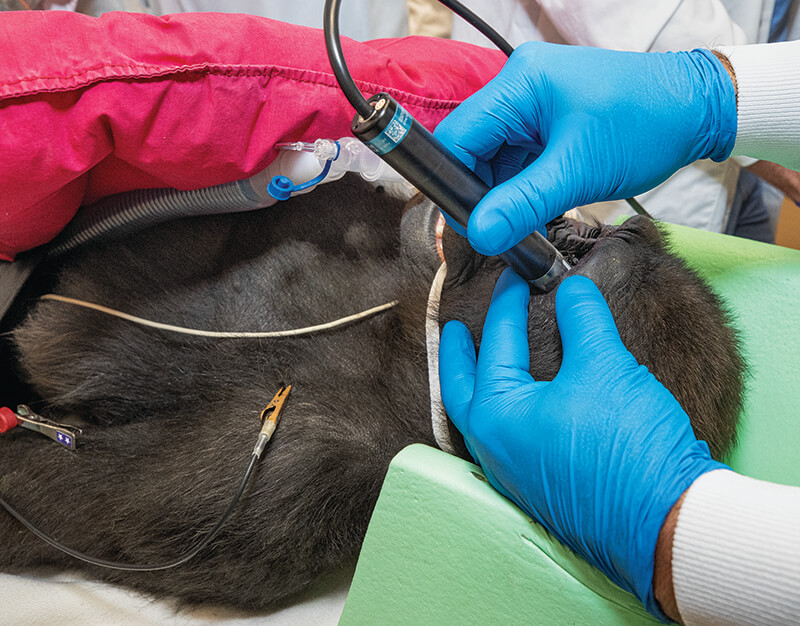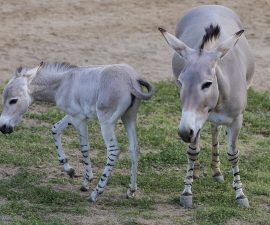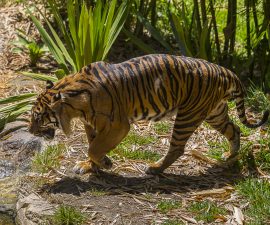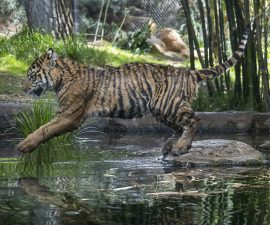BY Donna Parham
Photography by Ken Bohn
One evening last fall, as wildlife care specialist Breanne Murray brought the Safari Park gorilla troop inside for the night, she noticed something wasn’t quite right with the youngster of the troop, three-year-old Leslie. “Although she wasn’t displaying any behavioral symptoms, her left eye was cloudy—it had become completely opaque,” says Breanne.
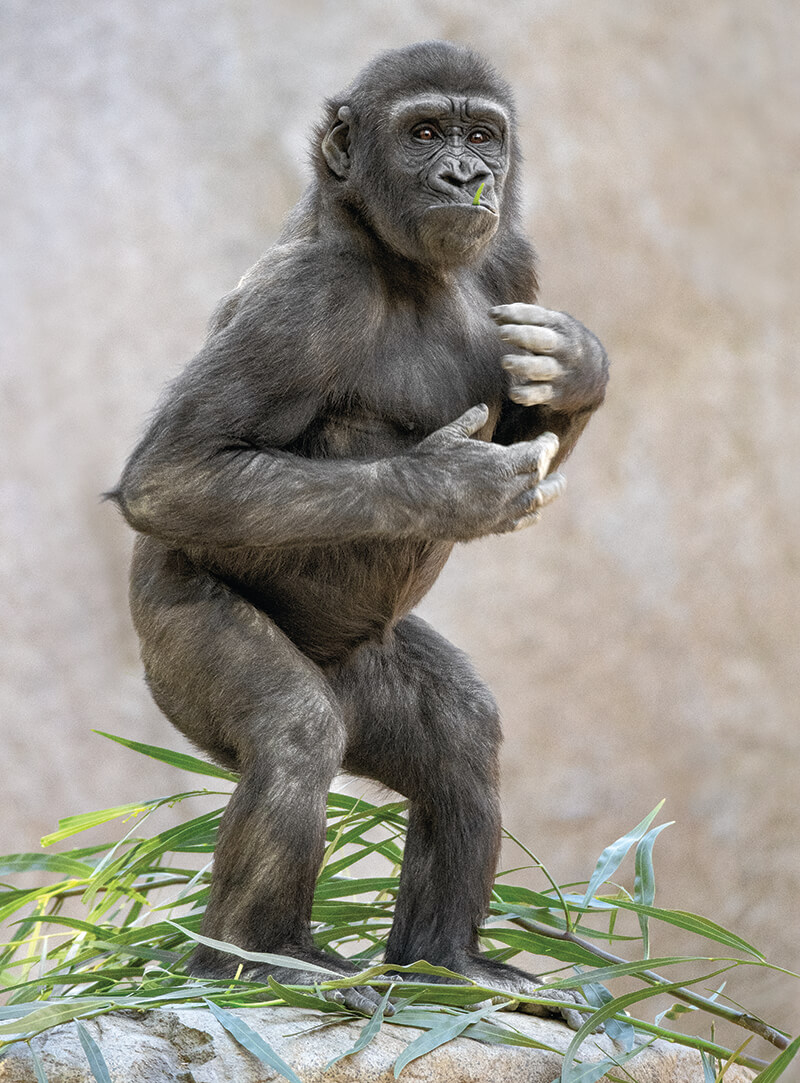
SEEING CLEARLY NOW
Leslie takes time out from playing to get a better look at Safari Park visitors—who are enjoying her antics.
“At first, we didn’t know for sure what was wrong,” says Park veterinarian Meredith Clancy, DVM. “But it looked like a cataract.” Dr. Clancy has worked with veterinary ophthalmologists on cataract surgeries for lions and birds, but because primates are more similar to humans, she wanted to consult a human ophthalmologist. She reached out to Christopher Heichel, M.D., an ophthalmologist with UC San Diego Shiley Eye Institute, who has experience with cataracts in younger patients. “From the moment we started talking to Dr. Heichel, he seemed like the best technical expert for this problem,” says Dr. Clancy.
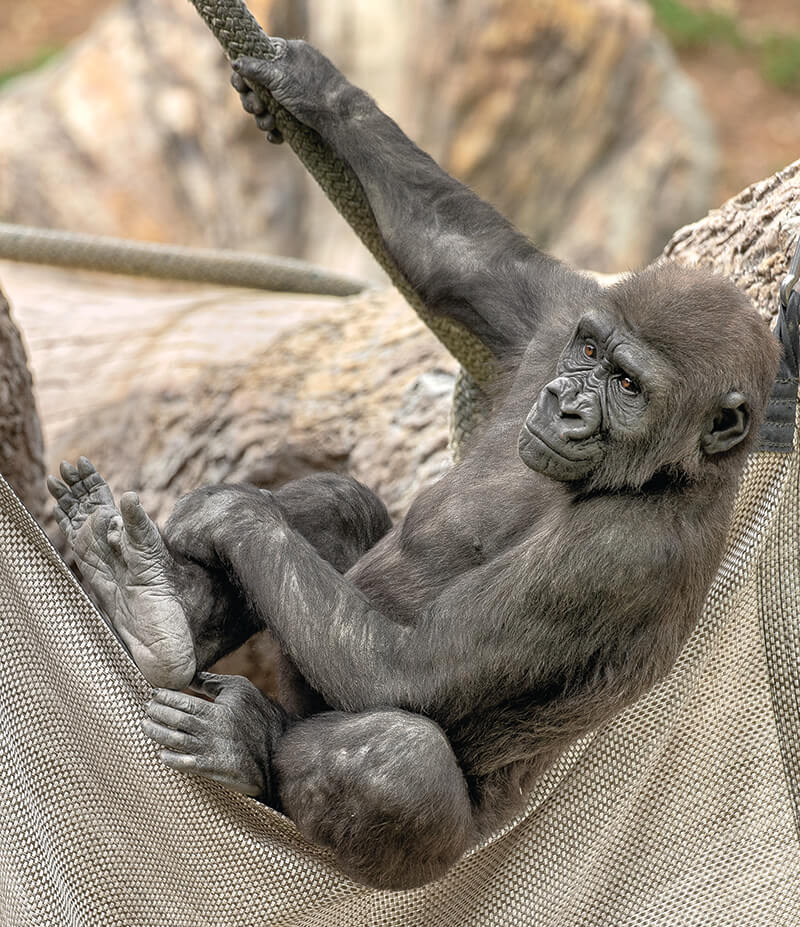
BABY GIRL
The beloved “baby” of the Safari Park’s troop, Leslie was born October 19, 2016, to mom Kokamo and troop leader Winston.
Dr. Heichel jumped at the chance to help. “It took me less than a second to know that this surgery was something I wanted to do,” he says. “And my next thought was, ‘How?’” While Dr. Heichel performs a lot of challenging eye surgeries, Leslie would be his first nonhuman patient. His first order of business was a house call, but protective mom Kokamo wasn’t keen about allowing this stranger close to her youngster. With a portable ophthalmoscope, Dr. Heichel was able to get a quick glimpse into Leslie’s eye before mom scooped her away. He diagnosed her with a cataract that probably resulted from an injury—likely sustained while playing and roughhousing with her siblings.
Knowing that planning and logistics for an eye surgery would take some time, both doctors were eager to get the process started. Dr. Heichel explains that in human children, “The visual cortex stops processing images from the bad eye after a while.” Waiting too long might mean that Leslie’s brain would essentially stop “seeing” with her left eye.
Leslie was too young to be separated from her mom, so the procedure had to involve Kokamo, too. “That increased everything exponentially,” says lead wildlife care specialist Peggy Sexton. The veterinary team immobilized both gorillas at the same time, so that mom and daughter could fall asleep together at the gorilla habitat and wake up together at the gorilla habitat. “I didn’t want mom to go to sleep before the baby did—and I didn’t want them to remember any of it, if possible,” Peggy says.
Once the two gorillas were anesthetized, teams of wildlife care specialists, veterinarians, and vet technicians jumped into action, driving them to the Safari Park’s Paul Harter Veterinary Medical Center. They bathed Leslie and trimmed her nails—to reduce the chance of introducing bacteria in case she rubbed her eyes. Then they moved the little gorilla into a sterile surgery room, where Dr. Heichel could take his first good look at Leslie’s cataract, under a microscope, and measure her eye.
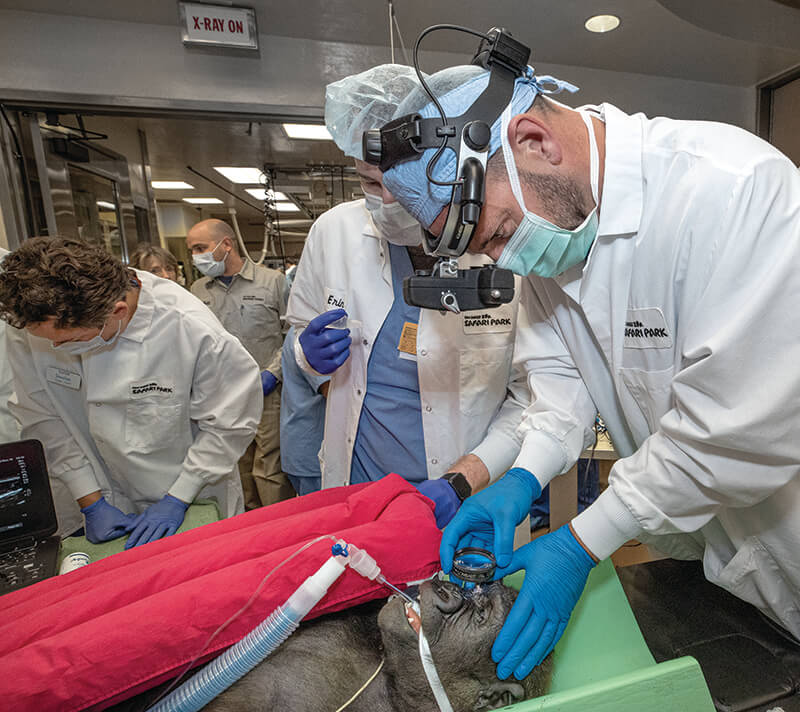
TAKING A GOOD LOOK
In surgery,Dr. Heichel was able to examine Leslie’s eye under a microscope. He depended upon what he knew from pediatric cataract surgeries to determine the best lens for the implant.
For Dr. Heichel, the surgery itself was the most comfortable part of the process. “It’s the exact same surgery as in humans,” he says. “The lens in a gorilla’s eye is essentially identical to ours.” He explains that the lens rests in a clear, membranous envelope, held in place by a ring of tiny fibers. In an eye injury, some of the fibers can be damaged, so he opted to insert a device called a tension ring, to help support the new lens. Then, just as he would do in a human, he made a tiny opening in the envelope to remove the clouded lens and implant the new, artificial one.
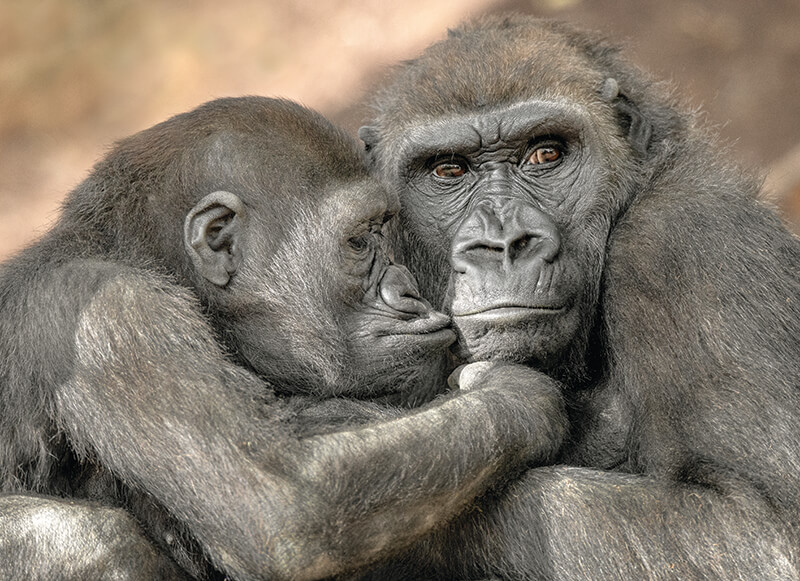
READY TO GO
Leslie is back in action, and that includes playing and cuddling with six-year-old Joanne.
“The unknown was how she would do postoperatively,” says Dr. Heichel, who knew there was “no way she was going to wear the usual postoperative, protective shield on her eye.” The day after the surgery, he visited the Safari Park to check on his patient. True to form, “Kokamo was a little suspicious of me,” he says. “She protectively scooped Leslie away.” Luckily, the wildlife care team took amazing, closeup photos and videos of Leslie’s eye. “They’re used to us taking our phones out and taking pictures of them,” says senior wildlife care specialist Kelly Casavant. “One of us holding a phone up to her face was nothing to her. We’d email them, and everyone could take a look.” (See sidebar to learn how wildlife care specialists administered post-op eye meds.)
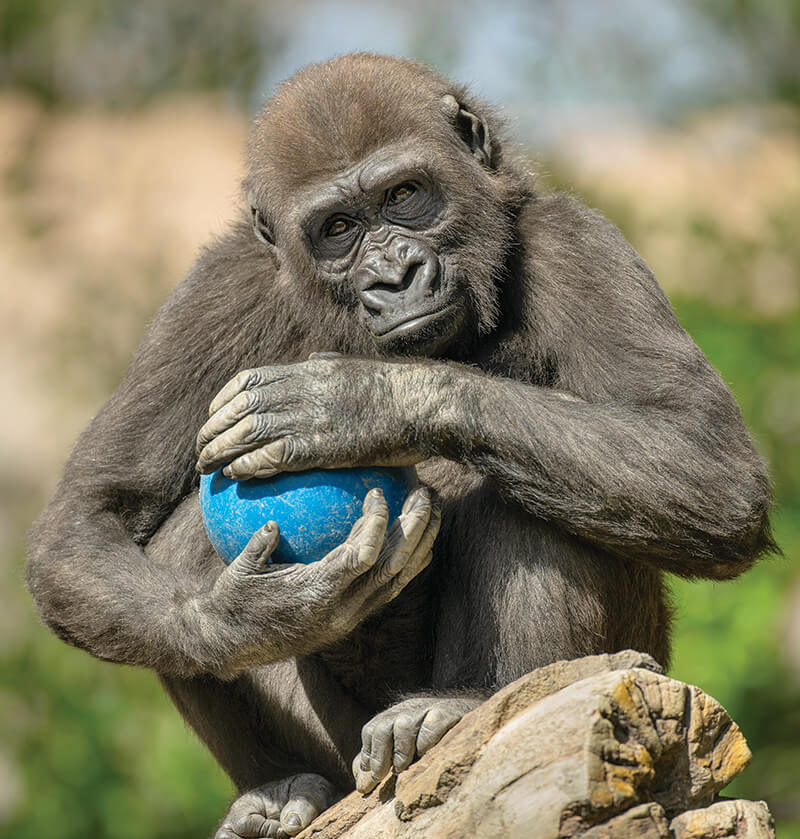
PLAYTIME
Leslie is a healthy, active three-year-old, and that means plenty of play throughout the day. Cataract surgery hasn’t slowed down this fun-loving girl one bit.
“The images were very reassuring,” says Dr. Heichel. Even better, Kokamo gradually accepted Dr. Heichel’s attention to Leslie. On one visit, when Kokamo noticed Dr. Heichel, she picked up her daughter…and carried her over to him so he could have a look at her. “That visit was so special,” he says.
Park visitors will attest that little Leslie is back to her usual self. “I am so grateful to have had this opportunity to work with the awesome team at the Safari Park and help a truly amazing animal,” says Dr. Heichel. While both Dr. Clancy and Dr. Heichel credit the wildlife care team with the success of the operation, the wildlife care specialists give the credit to the gorillas. Kelly says, “If it weren’t for Leslie and Kokamo being who they are, we wouldn’t have been able to do this.”
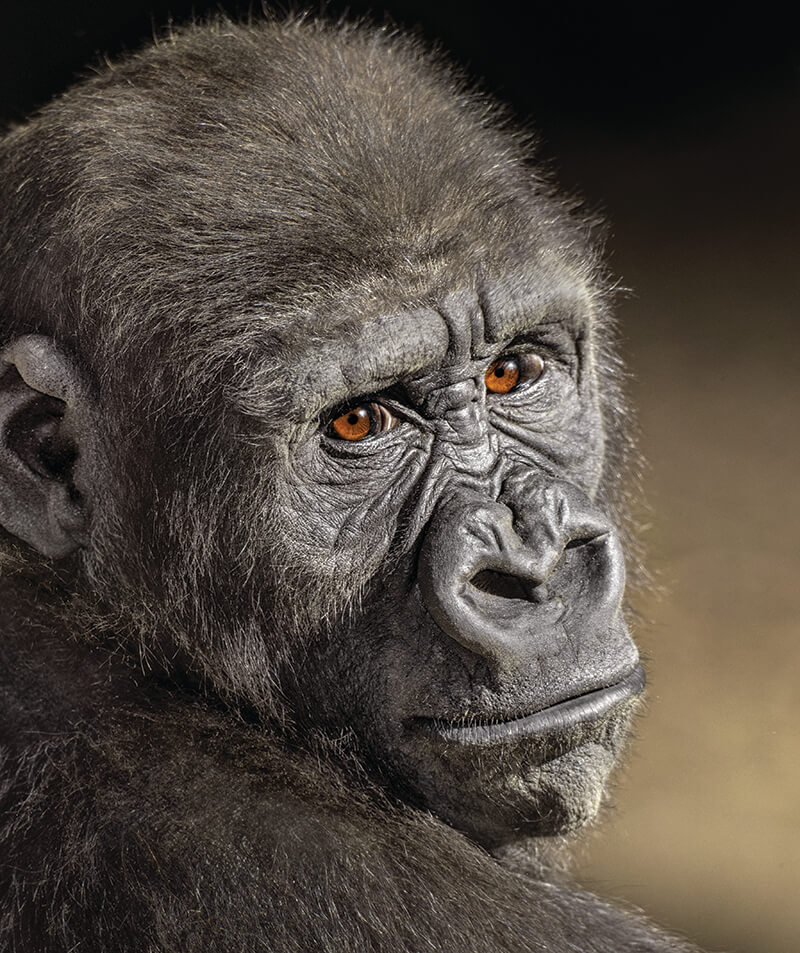
VISION FOR THE FUTURE
Dr. Heichel’s experience helped him select the right lens for Leslie. “I had to predict how much her eye is going to change as she grows,” he says. “The lens that would be just right for now, wouldn’t necessarily give her the best vision when she is a teenager or adult.” It’s the same decision he has to make with children. “As the eye grows, the vision will change slightly over the next few years.” For Leslie, “I used a lens that will give her better and better vision as she ages.”
Follow-up care
For weeks after the surgery, Leslie would need medication applied to her healing eye. Beforehand, “We did a lot of talking about, ‘How are we going to do this?’” says Kelly. Anyone who has had to give their pet medication can appreciate the challenge. “Gorillas don’t like water on them, and they certainly don’t like anyone putting stuff in their eyes,” she says. So the team set about desensitizing Leslie to the process, which was complicated by the fact that they had to occupy her mom Kokamo at the same time.
Eventually, Leslie allowed Kelly to drop a bit of saline solution into her eye. “She didn’t love it,” says Kelly, “but she tolerated it.” But just as things seemed to be going well, Leslie hit a developmental milestone. Like a human toddler, “She became more independent, and ‘said no’ more often, and drops in her eye were a big ‘no,’ so it was back to the drawing board.”
Kelly was pleased—and somewhat surprised—when Leslie allowed her to touch and massage around the little gorilla’s eyes. After the surgery, Leslie allowed her to apply medication by dabbing it into the corner of her eye—twice a day for 2 weeks, then once a day for 10 days. “How many times will a baby sit there and let you smear something like Neosporin in her eye as she’s eating something?” Kelly marvels. The secret to success turned out to be a smear of peanut butter frozen onto a wooden tongue depressor. “She had to work at it a little bit, and you have time to get the medicine in,” says Kelly. “She didn’t love us sticking our fingers in her eye, but she let us do it.”


